This website uses cookies in order to provide basic functionality. By continuing to use this website, you are consenting to their use. For more information, please read the relevant part of our privacy policy .

Primary Science Resources for the National Curriculum
Year 4 sound.
- Outstanding Science Year 4
Knowledge and Understanding
Statutory requirements, notes and guidance, lower ks2 - working scientifically.
Pupils explain how sounds are made and how we hear them. They describe sounds as moving waves and having high or low pitch or volume, while explaining the difference between these two properties. They apply their knowledge by making their own musical instruments and explaining how they make sounds. Pupils investigate pitch and volume, the relationship between the volume of a sound and its distance, and how sound can be insulated. They consider the difficulty of measuring sound without equipment, and explore solutions to this, such as taking multiple measutements. They record their measurements in tables and display them on line graphs.
How we hear things Worksheet Free!
Outstanding science year 4 | sound | os4d001.
- Description
- National Curriculum
- Key learning
Learning objective
I can explain how sounds are made and how we hear things.
Children learn that sounds are caused by vibrations. They learn that sounds travel from an object, through a medium (usually the air), travel into the ear where they are carried down the ear canal and processed by the brain. Children complete an explanation text explaining how we hear things, by cutting and pasting or writing their own descriptions.
- 4d1 : identify how sounds are made, associating some of them with something vibrating
Sound insulation Investigation
Outstanding science year 4 | sound | os4d002.
I can investigate how well sound travels through different materials.
Children investigate how effective 5 different materials are at blocking sound. Recognising the difficulty of accurately measuring the loudness of a sound, they make each measurement 3 times and choose the median. Children use their results to create a bar chart and place the materials in order of effectiveness as sound insulators.
- 4d2 : recognise that vibrations from sounds travel through a medium to the ear
Investigating pitch Investigation
Outstanding science year 4 | sound | os4d003.
I can place different sounds in order of pitch.
Children learn about the difference between pitch and volume. They carry out an investigation where they place 5 different water containers in order, depending on the pitch made when air is gently blown across the top of each. They attempt to find a pattern and explain their results.
- 4d3 : find patterns between the pitch of a sound and features of the object that produced it
Making a string instrument Investigation
Outstanding science year 4 | sound | os4d004.
I can make a tuned string instrument.
Children explore how a string instrument makes a sound. Using an ice cream tub, elastic bands, and Lego blocks, they create their own string instrument. They explore how adding more Lego blocks affects the pitch of each string (band).
Pitch and volume Investigation
Outstanding science year 4 | sound | os4d005.
I can place sounds in order of pitch and volume.
Children learn that pitch and volume are two different properties of sounds. Children investigate the pitch and volume of the sound made when 5 different balls are dropped. Recognising the difficulty of measuring pitch and volume without equipment, children make 5 measurements and then choose the modal value. Children transfer their results to a scatter graph showing both pitch and volume.
- 4d4 : find patterns between the volume of a sound and the strength of the vibrations that produced it
Investigating volume Investigation
Outstanding science year 4 | sound | os4d006.
I can investigate how to affect the volume of a percussion instrument.
Children investigate how dropping a weight from different heights ont a drum affects the volume of the sound produced. Recognising the difficulty of measuring volume without equipment, children take each measurement 5 times and find the mean. Children create a line graph showing their results and attempt to explain the relationship between the height of the weight and the volume of the sound made.

Sound and distance Investigation
Outstanding science year 4 | sound | os4d007.
I can investigate how distance affects how well we can hear a sound.
Working on the yard or in the school hall, children investigate the maximum distance at which somebody can hear one of 5 body sounds (hand clap, sniff, cough, foot stamp and thigh slap). They place each sound in order of loudness and create a bar chart showing their results. They discuss the difficulty of getting accurate results without measuring equipment and ways of improving the investigation.
- 4d5 : recognise that sounds get fainter as the distance from the sound source increases.
Distance and volume Investigation
Outstanding science year 4 | sound | os4d008.
I can investigate the relationship between distance and volume.
Working on the school yard, children investigate the height a ball needs to be dropped from in order to be heard at different distances. Children predict and then measure the minimum height required, recording their results in a table. They create a line graph and explore the link between the distance and the miniumum height (and therefore volume) required.
Get instant access to all of our Year 4 resources.
Outstanding science - year 4 contains all of the following units:.
Unit 4A - Living Things And Their Habitats
Unit 4B - Animals, Including Humans
Unit 4C - States Of Matter
Unit 4D - Sound
Unit 4E - Electricity
Outstanding Science
Primary science resources.
Browse resources
128 Gordon Drive Dovecot Liverpool England L14 7PZ
0151 558 1485
Terms and conditions
Privacy policy

Outstanding Science © Copyright Minerva Education Ltd. 2015-2024. Responsive design built upon Bootstrap .
- STEM Ambassadors
- School trusts
- ITE and governors
- Invest in schools
- Student programmes
- Benefits and impact
- Our supporters
- Advertising and sponsorship
- Become a STEM Ambassador
- Request a STEM Ambassador
- Employer information
- Training and support
- STEM Ambassadors Partners
- Working with community groups
- Search icon
- Join the STEM Community
Sound: listen up
This resource provides a selection of lesson plans, worksheets and teachers notes relating to sound at Year Four. They include activities which show that sounds are made when objects vibrate and that sounds travel through solids, liquids and gases. They also look at the structure of the ear, how vibrations are heard as sounds and discuss echoes and how bats or dolphins use echolocation. Ideas are also provided for investigating how well sound travels through different materials, discovering how instruments make sounds and exploring how to change the pitch and loudness. Provided by Hamilton Trust, these sessions have been written in line with the new national curriculum (published in 2013).
The Hamilton website also hosts a wealth of other free resources.
Show health and safety information
Please be aware that resources have been published on the website in the form that they were originally supplied. This means that procedures reflect general practice and standards applicable at the time resources were produced and cannot be assumed to be acceptable today. Website users are fully responsible for ensuring that any activity, including practical work, which they carry out is in accordance with current regulations related to health and safety and that an appropriate risk assessment has been carried out.
Show downloads
Share this resource, did you like this resource, lists that tag this content, year 4: sound , posted by, horrid henry rocks - sound , posted by, sound , posted by chamnett.

Year 4 Science: Making Sounds-Study notes, Worksheets and Online Practice Questions
Year 4 Maths Year 4 Science
Sound—what do we need to know?
What is sound?
- Sound is a thing that can be heard.
- The object that makes the sound is called a source.
How is a sound made?
- When objects vibrate, a sound is made.
- The vibration makes the air around the object vibrate and the air vibrations enter your ear. These are called sound waves.
- If an object is making a sound, a part of it is vibrating, even if you cannot see the vibrations.
How do we hear sounds?
- Sound waves travel to the ear and make the ear drum vibrate.
- Messages are sent to the brain which recognises the vibrations as sound.
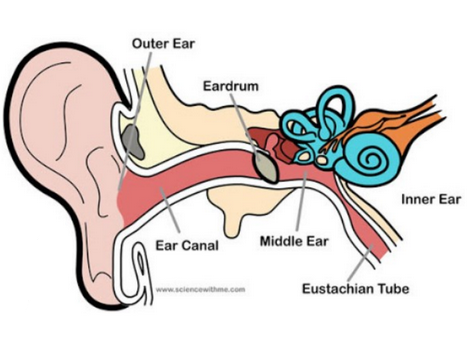
How do sounds travel?
- Sound waves travel through a medium (such as air, water, glass, stone, and brick).
How do we measure sound? Amplitude measures how strong a sound wave is.
Decibels measure how loud a sound is.
Frequency measures the number of times per second that the sound wave cycles.
How do sounds change?
- High pitch sounds are created by short sound waves.
- Low pitched sounds are created by long sound waves.
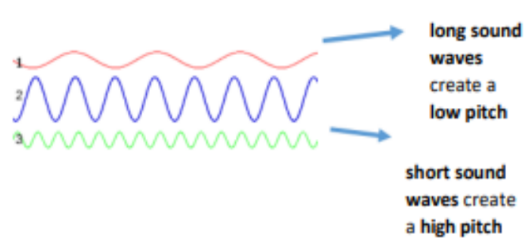
- The closer you are to the source of the sound, the louder the sound will be.
- The further away you are from the source of the sound, the quieter the sound will be.
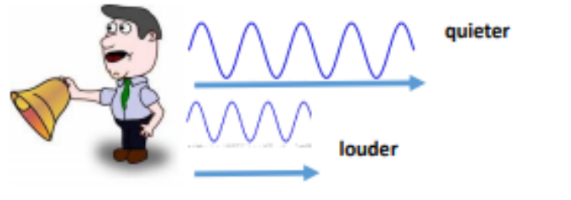
VIBRATIONS
Sound is made when an object vibrates and therefore causes the air around it to vibrate too. These vibrations are carried to your ear for you to hear them.
Sound vibrations can travel through different materials: SOLIDS: metals, stone, wood LIQUIDS: water GASES: air
Sound travels better through some materials than others. It travels very well through metal pipes for example.
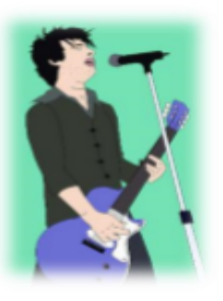
The louder the volume, the bigger the vibrations. The size of the vibration is called the amplitude. Quieter volumes have smaller amplitudes and louder sounds have larger amplitudes.

Sounds travel in a wave. The vibrations make air particles closest to the object vibrate, which then passes the vibrations to the particle next to it and so on – like dominoes falling!
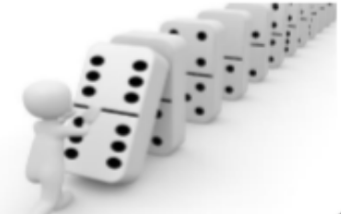
Focus Scientist
Alexander Graham Bell was a Scottish scientist who invented the telephone in 1876.
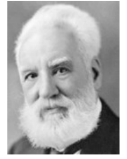
Beth O’Leary is a live sound technician and engineer who talks about sound engineering as a career and some of the issues that come from working in a male- dominated profession (see https://soundgirls.org/contributors/beth-oleary/).
Key Vocabulary
amplitude: a measure of strength of a sound wave.
decibel: a measure of how loud a sound is.
ear: the organ of hearing and balance. It has an outer part, a middle part and an inner part.
frequency: a measure of how many times per second a sound wave cycles.
insulation: material that stops the travel of energy (including sound).
medium: something that makes it possible to transfer energy from one location to another.
pitch: how high or low a sound is.
sound: a type of energy made by vibrations.
sound waves: invisible waves that travel through the air, water and solid objects as vibrations.
source: where something comes from.
transmit: to pass from one place or person to another.
vibration: invisible waves that move quickly.
volume: how loud or quiet a sound is.
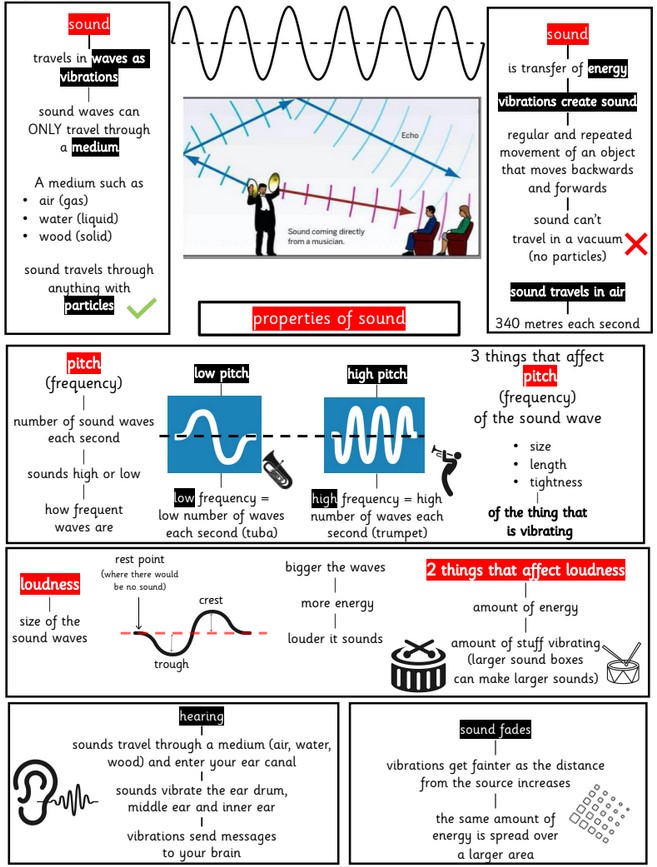
All sounds are caused by vibrators
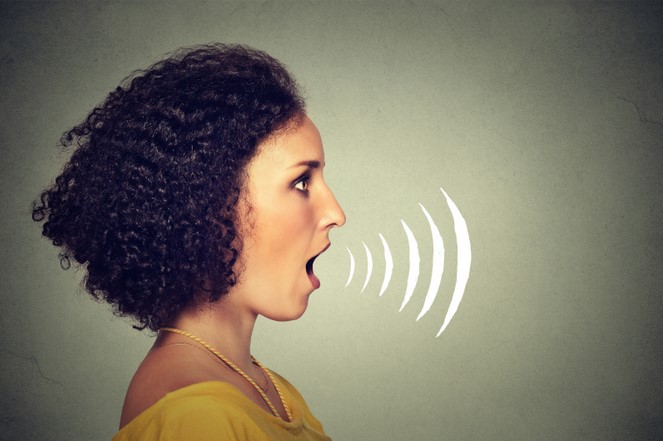
Pitch how high or low sounds are
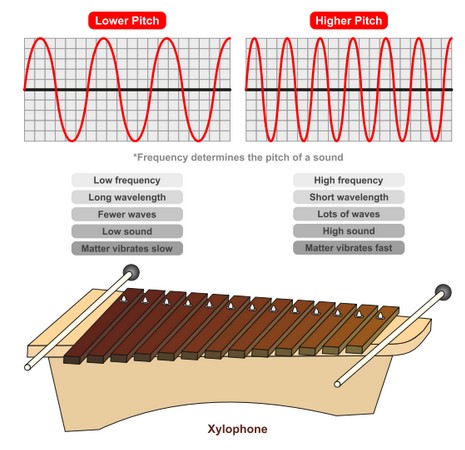
The longer bars of the xylophone have a lower pitch than the shorter bars
Sound waves with increasing pitch (also called frequency)
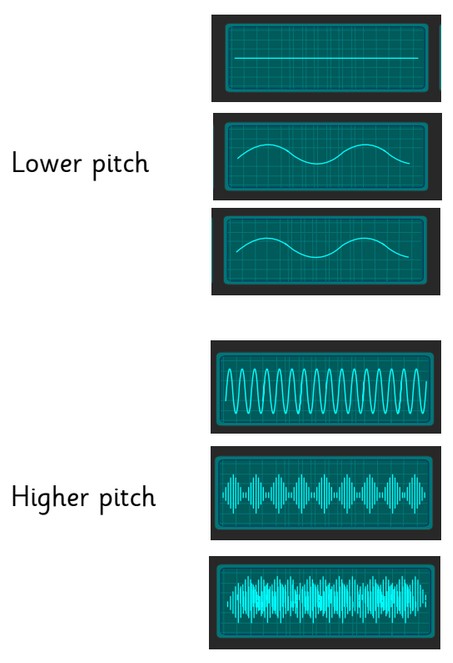
Sound travels as vibrations
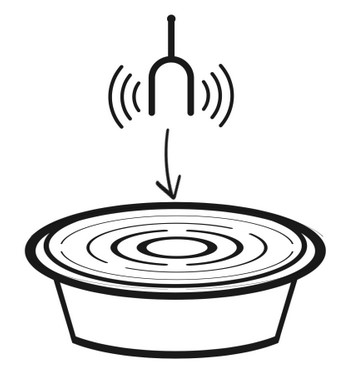
We can see vibrations when a tuning fork is struck and placed in the middle of a bowl of water.
Sound waves travel as vibrations down the tightened string
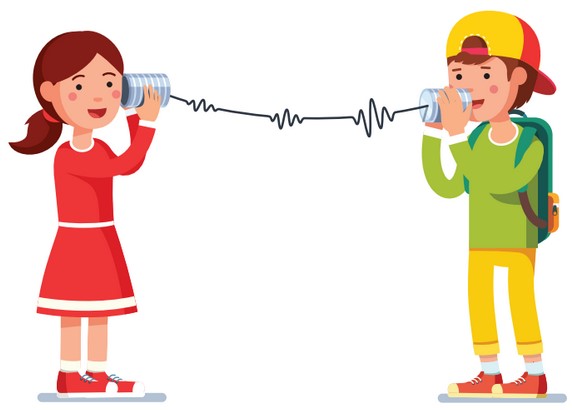
Sound travels most quickly through solids and liquids. It travels more slowly through air.
Sound waves cause other objects to resonate (vibrate in time with the original source)
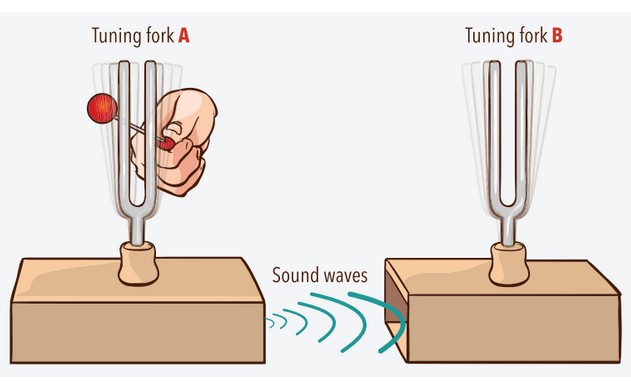
The loudness of sound is measured in decibels
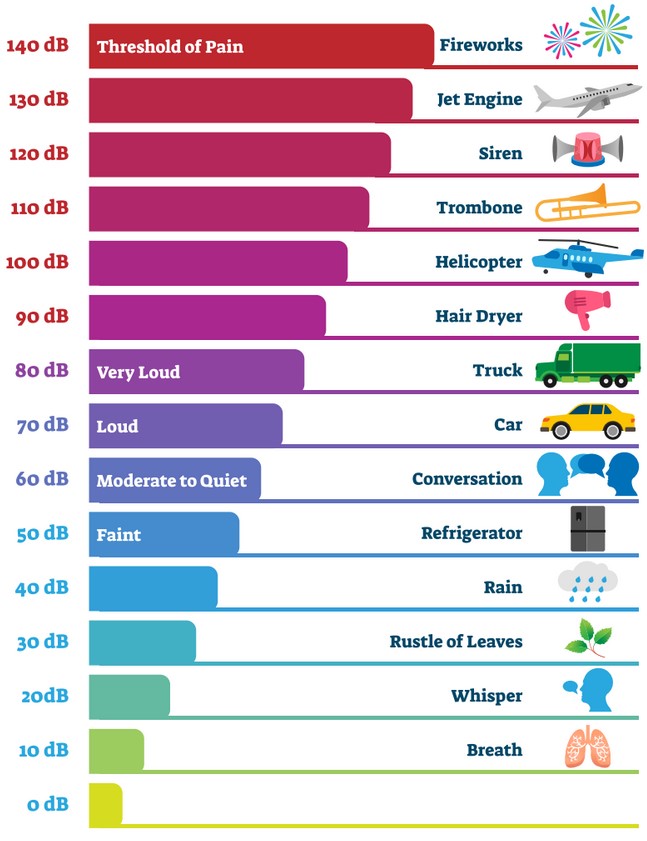
Anatomy of the ear
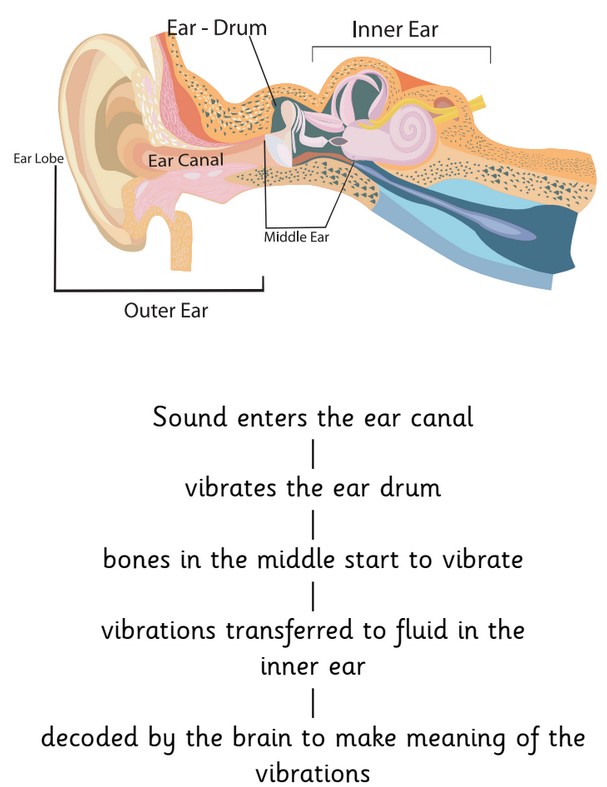
Sound waves cannot travel through space or a vacuum

Light can travel though space or a vacuum
Light travels at about 300,000,000 metres each second (m/s) (300,000 kilometres = 186,000 miles)
Sound travels in air at 340 metres each second (much less than 1 kilometre)
Making Sounds
Sound is caused by vibrations from a source such as a voice.
(Vibrate means move from side to side)
These make the air vibrate .
Which makes your ear drum vibrate and you can hear it!
Sound needs a material to travel through.
This is because there needs to be a material to vibrate .
Some materials are better at letting vibrations through than others.
Sound travels fastest through solid materials like metal and wood.
It travels quite fast through liquids like water.
It still travels through gases like the air.
Sound does not travel at all when there is no air, like in space. This is called a vacuum and would be completely silent.

IMAGES
VIDEO
COMMENTS
Year 4: Sound . This list consists of lesson plans, activities and video clips to support the teaching of sound at Year Four. ... Visit the primary science webpage to access all lists. Sound: listen up. Quality Assured Category: Science Publisher: Hamilton Trust. Finding out what children already know establishes a basis for their continued ...
Download free resources for Year 4 - Sound from Outstanding Science absolutely free! Supports the National Curriculum for Primary Science in KS2.
This resource provides a selection of lesson plans, worksheets and teachers notes relating to sound at Year Four. They include activities which show that sounds are made when objects vibrate and that sounds travel through solids, liquids and gases. ... Science: Age: 7-11: Published: 2010 to 2019: Published by: Hamilton Trust. View more ...
3. And we've even written science blogs for your child for every primary school year group: Reception. Year 1. Year 2. Year 3. Year 4 Year 5 Year 6 And finally, as well as sound science activities for your child, don't forget to visit Twinkl Go, where your child will find a range of fabulous interactive games.
The rock stars of the world need your help! They want their children to come to their concerts and rock-out, but they want to protect their precious ears! Find out all you can about sound; how it travels, pitch and volume. Then investigate materials to see which will provide the best insulation against sound. Be ready to present your ideas to a famous panel in this Year 4 Science Block.
Year 4. Sound. Curriculum download. Lessons (6) These resources will be removed by end of Summer Term 2025. ... In this lesson, we will learn about how sound travels, how we hear it in our ear and complete an experiment. 1 Slide deck. 1 Quiz. 1 Video. 2. 2.
Science. Introduction to sound. Sound insulation. New. New. Year 4. Sound insulation. I can investigate which materials are good sound insulators and describe how these are used in everyday life. Download all resources. Share activities with pupils. New. New.
This Science Year 4 unit will teach your class about sound, helping KS2 students to create quality scientific work. ... Retrieval Practice: Science: Sound: Year 4: Knowledge Organiser Quiz Pack. 4.8 (6 reviews) Retrieval Practice: Science: Sound: Year 4: Interactive Quiz. 5.0 (7 reviews)
This String Telephone Experiment KS2 Lesson Pack contains a set of resources that you can download and include in your lesson plan. Each of these resources has been specially made and tested by teachers, and they are ideal to use for a science lesson covering the topic of sound. In this lesson pack, you will find a PowerPoint presentation, activity sheets, and user guides to help you plan your ...
Key Vocabulary. amplitude: a measure of strength of a sound wave. decibel: a measure of how loud a sound is. ear: the organ of hearing and balance. It has an outer part, a middle part and an inner part. frequency: a measure of how many times per second a sound wave cycles. insulation: material that stops the travel of energy (including sound). medium: something that makes it possible to ...